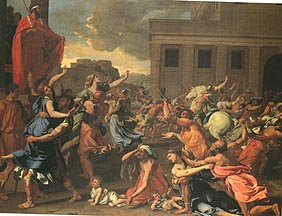ARTH Courses | ARTH 200 Assignments | Erotics of Absolutism
Excerpts from Diane Wolfthal
Images of Rape: The "Heroic" Tradition and its Alternatives
p. 7: To most art historians the word "rape" brings to mind Poussin's Rape of the Sabines, Titian's Rape of Europa, or some such depiction in which the assailant is a Greek or Roman god or hero. This type of image, which Susan Brownmiller terms "heroic" rape, has always received considerable attention. Horst Janson's popular introductory text includes nine rape scenes; all but one are of the "heroic" type. Frederick Hartt's History of Italian Renaissance Art discusses seven, all "heroic." Not only undergraduate texts but also scholarly publications have focused on this type of representation. Even revisionist studies of the last decade such as Margaret Carroll's article on Ruben's Daughter of Leucippus and James Saslow's book on Ganymede continue this practice. The subject of "heroic" rape imagery is extremely complex and this chapter will explore only two aspects. The first section will examine how these glorify, sanitize, and aestheticize sexual violence; the second section will investigate how art historians have reinforced this construction.
The Images
Poussin's Rape of the Sabines, painted in the 1630s and today in the New York Metropolitan Museum, may well be the rape image most familiar to American art historians. It illustrates an episode from the early history of ancient Rome. The Romans, unable to obtain wives peacefully, staged a festival, invited the neighboring Sabines, and, at a signal from Romulus, each violently seized a Sabine woman. Art historians /p. 8: generally focus on Poussin's classical style or his sources in ancient art and literature. The painting is often termed "heroic" or cited as an embodiment of Poussin's belief that the highest goal of art is the depiction of noble human action. Avigdor Arikha, for example, finds the work "sublime...heroic...divine" and argues that "Poussin looked for nobility in his subject."
Certainly
in Italy, in the fourteenth through the seventeenth centuries, the incident
was viewed as a heroic, patriotic act. The Sabine women were revered as the
mothers of the first Romans. Their story adorned wedding banners, marriage
chests, and the apartments of noblewomen. The name Talassius, that of a Roman
who obtained an especially beautiful Sabine, became a wedding motto. The Sabine
legend was considered essential to the founding of Roman family life and to
the future of the nation. In the late sixteenth century it was included in
painting cycles illustrating heroic events from Roman history. 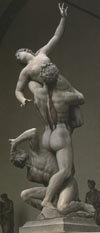 Giambologna's
statue of 1583, christened the Rape of the Sabine Woman soon after
its completion, was displayed in the main public square in Florence, the Piazza
della Signoria.
Giambologna's
statue of 1583, christened the Rape of the Sabine Woman soon after
its completion, was displayed in the main public square in Florence, the Piazza
della Signoria.
/p. 9: Poussin makes clear that the Romans are seizing women against their will. Several Romans have drawn their swords; some chase, grab, or hold the women. The Sabines' expressions are anguished. They kick, struggle, try to escape. Other figures underline the terror of the event. Infants life abandoned on the bare earth. A distraught old woman and an aged father complete the foreground frieze. Clearly Poussin is suggesting her that women, children, and the elderly pay the price for the "heroic" founding of Rome. Nevertheless, Poussin justifies the incident.
Not only does the artist reflect Roman attitudes by idealizing the crimes of their ancestors, he also accepts the Roman concept of raptus, which was quite different from the modern definition of rape. In ancient Rome, raptus meant "carrying off by force;" it was a crime of property and included thefts of all kinds. If violence was a necessary component of this crime, sexual intercourse was not. Similarly, in Poussin's painting, although the sexual aspect is implied, intercourse is not explicitly depicted. Roman law did not view the crime from the woman's point of view. Rather raptus was a crime against the woman's husband or guardian. Poussin reflects this view of rape in the major figure group on the right, which shows a Sabine father struggling against a Roman abductor.
While most of the women resist the Romans and strain toward the right, there is one, in the middle ground, who does not. Rather, she turns to her companion, apparently listening to him, as they stroll off together toward the left. Several factors draw our eye to her: her position, just left of center; the arc of empty space to her right; and the color of her robe, the same blue worn by the large Sabine women in the foreground. With this couple Poussin reminds the viewer that, as Plutarch had related, the Sabines soon accepted their husbands. This couple serves to downplay the ugliness of the event. In fact, Poussin's style --his frozen action, controlled emotional expression, and carefully ordered composition-- serves to distance the viewer from the horror of the event. This work echoes the Roman attitude, typified by Ovid's remark concerning the rape of the Sabines: "Grant me rewards such as these, [and] I would enlist for the wars."
Marriage as Rape in Renaissance Italy
These features of Poussin's Rape of the Sabine Women-- aestheticization of rape; the sanitization of the violent and sexual aspects of the theme; the focus on the point of view of the rapist and the male relatives of the victim; the suggestion of a happy ending --are typical of early modern "heroic" rape imagery. But the context in which such images are found /p. 10: varies. The three primary functions of "heroic" rape imagery produced during the fifteenth through seventeenth centuries were to elucidate marital doctrine, to serve as erotic stimulation, and to assert the political authority of aristocratic patrons.
The earliest
of these contexts to emerge was the marital. From about 1465 to 1520, "heroic"
rape themes adorned two types of art that were commissioned by leading Tuscan
families on the occasion of a son's wedding: panels on cassoni (i.e.
wooden chests) and spalliera (i.e. shoulder-high wall decorations
made for a domestic setting). The most famous example of this type may well
be Botticelli's Primavera, commissioned to commemorate the marriage
of Lorenzo di Pierfrancesco de' Medici to Semeramide d'Appiani in May 1482.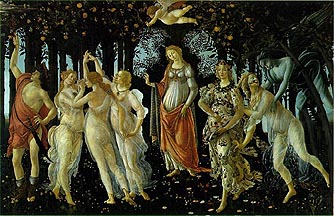
At the far right of this composition, the west wind Zephyrus tries to seize the nymph Chloris. Ovid's Fasti relates that Zephyrus raped Chloris, married her, and then transformed her into Flora, whom Botticelli depicts to the left of Chloris. Typical of "heroic" rape imagery, it depicts neither overt violence nor sexual intercourse. Indeed, Chloris seems to suffer no great harm....
/p.12: Marital paintings were decorated with a range of "heroic" rape subjects, not only the Rape of the Sabines, but also those of Europa, Io, Leda, Proserpina, and the attempted rape of Daphne. What was the message of such paintings? In part, as several scholars have shown, they functioned as lessons for the bride: they served to visualize the ideal traits that were expected of a new wife. Chief among these was chastity, but images such as the Rape and Reconciliation of the Sabines also idealized submissiveness to husband, sacrifice for family and country, and woman's role as peacemaker within the family.
One motif that appears in most "heroic" rape scenes made for a marital context, including Botticelli's Primavera..., has never been fully explored: that of the woman running frantically away from her pursuer. What was the meaning of this motif? Certainly, on one level, it indicates the woman's desire for chastity, since she flees a man who pursues her for sexual reasons. On another level, it suggests the reluctance that many Renaissance brides must have felt, since they had little say in whom they would marry. But the motif also reinforces the idea of sexual relations as a king of hunt....
/p. 15: Roman culture continued to link marriage and "heroic" rape. A sarcophagus, dated shortly before the second century B.C.E. and well known /p. 16: in Renaissance Florence, shows the rape of the daughters of Leucippus by the Dioscorides on the front and their marriage on the sides. On the main relief a frightened companion of the victims marks the center of the relief. The seizure of the women is shown in two groups, to either side. Typical of "heroic" rape imagery, the Diocorides are not shown in the act of sexual intercourse, nor do they use weapons. But the victims' thrashing heads and flailing arms make clear their lack of consent....
/p. 17: The sides of the sarcophagus reveal the "happy ending" of the story: the marriage of the Diocorides to the daughters of Leucippus. The women, now dressed in bridal veils, calmly accept their fate. As in so many images of "heroic" rape, they have apparently suffered no great harm. All evidence of sexuality is eradicated in the wedding scenes. Although on the front, the women's drapery had slipped down, revealing their breasts, on the sides of the sarcophagus, their bodies and hair are decorously covered....
"Heroic" Rape as Erotica
Guido Ruggiero has concluded that beginning in the High Renaissance, there arose an "aversion to marriage and a common celebration of sexual freedom for males beyond the morality of society and religion. Per- /p. 18: haps it is no coincidence then that after 1500 a second type of "heroic" rape image developed, which functioned as erotica for the male viewer.
 Poems
published on the occasion of the unveiling of Giambologna's Rape of the
Sabine Woman imagine young men lured to the statue by the Sabine woman.
One poet, Bernardo Davanzati, writes: "This, my Giambologna, is your
Sabine from whom you burned with desire...."
Poems
published on the occasion of the unveiling of Giambologna's Rape of the
Sabine Woman imagine young men lured to the statue by the Sabine woman.
One poet, Bernardo Davanzati, writes: "This, my Giambologna, is your
Sabine from whom you burned with desire...."
There were
two primary ways in which "heroic" rape images were constructed
to appeal to the erotic tastes of the male viewer. Some artists simply
disregarded the standard literary versions of the myth and depicted the rape
as if it were a seduction. For example, Correggio's Jupiter and Io, painted in the early 1530s for Frederigo II Gonzaga, then marquis of Mantua,
falls into this category. Best known for its sensual qualities, the canvas
shows Jupiter, disguised as a dark cloud, embracing Io. Commissioned as one
of a series of canvases depicting the erotic pursuits of the Roman gods, its
rich tones, hazy atmosphere, and the soft warm flesh of a beautiful woman
contribute to its sensual mood.
painted in the early 1530s for Frederigo II Gonzaga, then marquis of Mantua,
falls into this category. Best known for its sensual qualities, the canvas
shows Jupiter, disguised as a dark cloud, embracing Io. Commissioned as one
of a series of canvases depicting the erotic pursuits of the Roman gods, its
rich tones, hazy atmosphere, and the soft warm flesh of a beautiful woman
contribute to its sensual mood.
Susan Brownmiller observed that goddesses and mortal women raped by ancient Greek or Roman gods or heroes "rarely suffered serious consequences." Indeed, when we look at Correggio's painting, we feel no /p. 19: pain, terror, or revulsion. Although contemporary marital paintings show Jupiter chasing a terrified Io, Correggio shows no violence. This contradicts Ovid, who related that Jupiter "caught the fleeing maiden and ravished her." Correggio instead depicts Jupiter as a tender lover whom Io welcomes. Her head rolls back in a swoon; her lips part in ecstasy; her /p. 20: arms embrace the god. Correggio's image, like so many "heroic" rape depictions, serves to blur the distinction between an erotic interlude and rape. Typical of "heroic" rape imagery, the artist avoids any explicit depiction of sexual intercourse. Rather, Correggio reinforces ancient Roman attitudes by idealizing the rape. The painter, in search of an erotic subject, chose a "heroic" rape myth and then subverted its narrative so that the victim is constructed as a willing lover.
Other eroticized "heroic" rape images reveal an undercurrent of violence. For example in Giambologna's statue, the Sabine woman pulls away from her Roman assailant, attempting to free herself from his grasp. Her arms flail in protest; her brow is furrowed; her downturned mouth is opened as if to cry out. Unlike Io, she is clearly not a willing lover. Cinquecento viewers would have interpreted this sculpture as a rape scene. Rape victims were required to prove in court that they had resisted and cried out -- precisely the actions of the Sabine woman. Furthermore, a poem written on the occasion of the unveiling of the statue notes that its Roman violator would have been arrested for a criminal offense had his action occurred in sixteenth-century Florence....
/p. 22: The Political Context of Eroticized "Heroic" Rape Imagery
"Heroic" rape imagery was often multivalent. Marital images at times served an erotic function, as a glance at the Primavera suggests, and erotic representations often operated on a political level as well. Recent scholarship has established that class was a determinant factor in patronage patterns for erotic images of "heroic" rape. In particular, princes throughout Europe asserted their political authority through such works.
Charles Hope
has noted that Titian produced two types of erotica. Some, such as his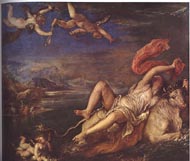 Rape of Europa , painted for Philip II over the years 1559-62, showed
mythological subjects. These were viewed as "high" art and commissioned
by aristocratic patrons who lived outside Venice. Other erotic paintings,
lacking a classical veneer, were produced for less patrons, generally Venetian.
All across Europe, from Florence to Prague, courtly patrons commissioned "heroic"
rape imagery; this was an activity that was expected of a prince....
Rape of Europa , painted for Philip II over the years 1559-62, showed
mythological subjects. These were viewed as "high" art and commissioned
by aristocratic patrons who lived outside Venice. Other erotic paintings,
lacking a classical veneer, were produced for less patrons, generally Venetian.
All across Europe, from Florence to Prague, courtly patrons commissioned "heroic"
rape imagery; this was an activity that was expected of a prince....
/p. 23: Why did this type of erotica appeal to the upper classes? Contemporary sources make clear that "heroic" rape imagery aroused not only sexual desire but also feelings of omnipotence. Ginzburg traces one root of this idea from ancient Rome to sixteenth-century Italy. In Terence's The Eunuch, a young man, upon viewing a painting of Jupiter and Danaë in the home of a woman he loves, becomes sexually aroused. As a voyeur observing an erotic image, he imagines himself in Jupiter's place. Merely an ordinary man ("a mere manikan," as he describes himself), through his gaze he is able to identify with the most powerful of gods. This identification is not purely sexual; the young man remarks on the god's tremendous power, he "whose thunder shakes the highest realms of heavens." Through sexual intercourse the young man feels closer to Jupiter's immense power.... Through the male viewer's identification with a divine or heroic assailant, eroticized paintings of "heroic" rape imagery served to arouse feelings of moth sexual excitement and omnipotent power....
Similarly,
in the early modern period, as Margaret Carroll has shown, forcing a woman
to submit sexually was viewed as parallel to dominating one's subjects politically.
Citing a wide range of sources, Carroll has convincingly shown that aristocratic
rulers identified with Roman gods and heroes who possessed absolute power
and operated above the law. Relying on action, not thoughtful reflection,
these classical figures were able to violently subjugate others. Although
"heroic" rape imagery at times suggests the destructive results
of this subjugation, it nevertheless constructs the hero as an admirable figure,
virile, strong, and courageous, whose fame rests in part on his acts of sexual
violence. Walter Friedlaender remarked that Giambologna's statue "served to exemplify the much admired patriotism and resolutions of early
Rome that permitted any act, even a ruthless or barbarous one, which would
assure the future of the nation."
"served to exemplify the much admired patriotism and resolutions of early
Rome that permitted any act, even a ruthless or barbarous one, which would
assure the future of the nation."
/p. 24: While
most "heroic" rape paintings belonged to princes' private collections,
at least one, Giambologna's Rape of the Sabine Woman, was displayed
publicly. Grand Duke Francesco de' Medici ordered it installed in the Loggia
dei Lanzi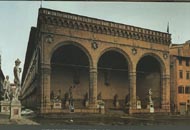 , which is situated on the south side of the main square in Florence, the
Piazza della Signoria, and at right angles to the Palazzo Vecchio, the seat
of political power. Here the sculpture publicly proclaimed the power of the
Medici dynasty. But Carroll has also proposed that the statue suggested "the
dominion" all men enjoyed "over the women in their own homes."
In this way, the sculpture "helped create an empathetic bond between
ruler and ruled that span[ned] class divisions." Clearly feelings of
omnipotence were not confined to aristocratic circles. Rather, "heroic"
rape imagery could arouse similar feelings in the ordinary male citizen of
Florence. Indeed, this thirteen-foot-high sculpture showing a man seizing
a woman against her will was greeted with tremendous enthusiasm in sixteenth-century
Florence, as the numerous copies and poems in its honor demonstrate....
, which is situated on the south side of the main square in Florence, the
Piazza della Signoria, and at right angles to the Palazzo Vecchio, the seat
of political power. Here the sculpture publicly proclaimed the power of the
Medici dynasty. But Carroll has also proposed that the statue suggested "the
dominion" all men enjoyed "over the women in their own homes."
In this way, the sculpture "helped create an empathetic bond between
ruler and ruled that span[ned] class divisions." Clearly feelings of
omnipotence were not confined to aristocratic circles. Rather, "heroic"
rape imagery could arouse similar feelings in the ordinary male citizen of
Florence. Indeed, this thirteen-foot-high sculpture showing a man seizing
a woman against her will was greeted with tremendous enthusiasm in sixteenth-century
Florence, as the numerous copies and poems in its honor demonstrate....
/p. 25: It
is striking that no woman artist, to my knowledge, produced a "heroic"
rape image during the Renaissance or Baroque periods. But Artemisia Gentileschi
did paint images of sexual violence, such s those of Susannah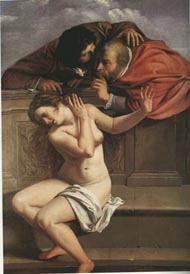 ,
which, Mary Garrard has demonstrated, constructed Susannah quite differently
from those by contemporary male artists.
Expressing a subversive voice, the artist sympathized with the victim, and
movingly depicted her vulnerability and the anguish of sexual violence. Inverting
the usual reading of such legends, she refused to show Susannah as a seductress
or an object of sexual desire....
,
which, Mary Garrard has demonstrated, constructed Susannah quite differently
from those by contemporary male artists.
Expressing a subversive voice, the artist sympathized with the victim, and
movingly depicted her vulnerability and the anguish of sexual violence. Inverting
the usual reading of such legends, she refused to show Susannah as a seductress
or an object of sexual desire....
[A] glance at the canonical "heroic" rape images by Poussin, Titian, Correggio, and Giambologna supports Helen Hazen's assertion that "rape is a significant and often even a grand act in myth and literature [although] it is generally a very sordid and terrible one in life." Images have power; they don't simply reflect reality, but can influence attitudes and this way affect actual events. To cite but one example, the blurring of seduction and rape, which we explored in Correggio's Io, was not confined to the cultural domain but spilled over into the legal arena.
